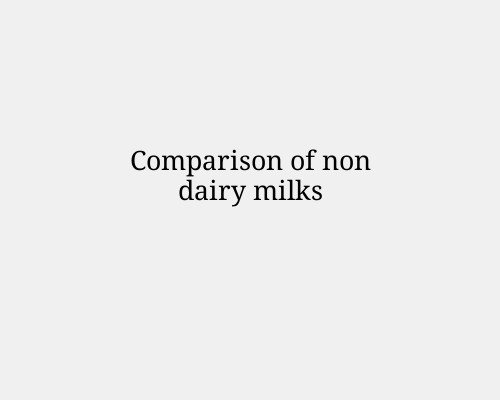
Nutritional Highlights & Expert Guidance
Top-Ranked Options for Toddlers
Experts repeatedly emphasize that for toddlers (age 12 months and up), the best non-dairy milks are those that closely match cow’s milk in protein, calcium, and vitamin D—with fortified soy milk, pea protein milk, or soy-pea blends being the most nutritionally appropriate. (healthydrinkshealthykids.org, Healthy Eating Research)
Key Nutritional Criteria
According to dietary guidelines:
Protein: Aim for around 7–8 g per 240 mL serving.
Calcium: Fortified to ≥ 276 mg per 240 mL.
Vitamin D: At least 100 IU (≥ 2.5 µg) per 240 mL.
Potassium and B₁₂ are also important if the child is on a vegan diet. (Healthy Eating Research)
Nutrient Profiles of Various Plant Milks
A side-by-side comparison (based on unsweetened, unflavored fortified versions) gives us:
Milk Type Protein Calcium
Vit D
Calories Notes
(g)
(mg)
(µg)
Soy Milk (fortified) 7 g ~300 ~3 µg ~80
Closest match overall (healthydrinkshealthykids.org, U.S. Food and Drug Administration, Wikipedia)
Pea Milk ~8 g Varies Fortified ~70 Strong protein, more sustainable
(Wikipedia, The Washington Post)
Oat Milk (fortified)
~2 g
~350–460
~4–6 µg
~90
Good calcium, low protein
(healthydrinkshealthykids.org,
EatingWell, Wikipedia)
Lower/still
Generally not recommended as main milk for toddlers — poor
Almond/Coconut/Rice ~0–3 g
needs fortification
Often lower
Very low
protein & nutrient profiles (healthydrinkshealthykids.org, Verywell Family, Wikipedia)
Other Important Considerations
Rice milk: Very low protein, high carbs, and arsenic concerns for young children; generally not recommended for toddlers. (Wikipedia)
Coconut milk (beverage): Low in protein and high in saturated fat—not ideal as a primary milk replacement. (Verywell Family, HealthyChildren.org)
Oat milk does contain fiber (2 g) and beta-glucans beneficial for heart health—but it's still protein-poor. (Wikipedia, EatingWell)
Growth data: Some studies (e.g., one measuring plant-based milk consumption in children 1–10 years) indicate modest reductions in weight/height when plant milks are used as the main milk source—highlighting the need for careful dietary balancing. (jn.nutrition.org)
Expert Recommendations
Pediatric and nutrition authorities recommend that fortified soy milk—and increasingly pea milk—are the best non-dairy casings for toddlers (≥ 12 months). (healthydrinkshealthykids.org, Healthy Eating Research, Wikipedia)
If soy or pea is not feasible due to allergy or preference, rotating with other fortified plant- based milks can help—but additional protein-rich foods must be included in the toddler's diet. (Verywell Family, healthydrinkshealthykids.org, Healthy Eating Research)
Local (South African) Product Options
Here are some fortified non-dairy milk products available in South Africa that align with nutritional priorities:
Good Hope Soy Milk Unsweetened
Protein-rich, fortified soy—closest match to cow’s milk
R 36,99
Okja Oat Milk
Creamy oat milk—fortified, but lower protein
R 45,00
Good Hope Soy Milk Unsweetened
A fortified soy milk—in line with toddler-friendly nutrients (protein, calcium, vitamin D). Unsweetened version helps keep added sugar at bay.
Okja Oat Milk
Oat milk that's calcium- and vitamin D–fortified. Offers creaminess and good micronutrients, but is much lower in protein compared to soy or pea.
(Note: Availability and prices vary across retailers like Clicks, Dis-Chem, and Takealot.)
Recommendations for Your Toddler
Choose fortified soy milk (like Good Hope Soy Milk) as the primary non-dairy milk—it provides the closest match to cow’s milk in protein, calcium, and vitamin D.
Consider rotating in fortified oat milk (e.g., Okja Oat Milk) for variety and texture, but be sure to include ample protein-rich foods (eggs, tofu, legumes, nut butters) throughout the day.
If available, look into pea protein milk brands, as pea milk also offers high protein (~8 g) and may be more sustainable—though local availability may be limited for now. (The Washington Post, Wikipedia)
Always stick to unsweetened and unflavored versions—this avoids excess sugars.
Rotate milk types and complement diet: a variety of fortified plant milks plus whole foods will ensure nutrient diversity.
Consult your pediatrician or a registered dietician, especially if your toddler has allergies or dietary restrictions; they can guide fortification needs and help monitor growth.
Summary Table
Goal Best Choice Why It Matters
High protein Fortified Soy or Pea Milk Supports growth and
development
Calcium & Vitamin D supply
Fortified Soy, Pea, or Oat Milk Maintains bone health
Low added sugar Unsweetened versions Supports healthy eating habits
Variety & nutrient diversity
Rotate among fortified milks + foods
Covers broader nutrient spectrum
Sustainability (bonus) Pea Milk Lower carbon & water footprint